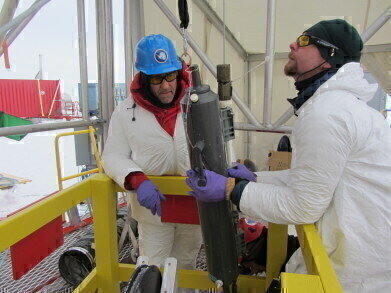-
 Dr Andrew Mitchell (right) and Professor John Priscu from Montana State University with a water sample brought up from Lake Whillans, which lies 800 metres below the West Antarctic Ice Sheet. Photo: J Mikucki
Dr Andrew Mitchell (right) and Professor John Priscu from Montana State University with a water sample brought up from Lake Whillans, which lies 800 metres below the West Antarctic Ice Sheet. Photo: J Mikucki
News
Bacteria Exert Control over Ice-Locked Methane
Oct 16 2017
A lake beneath Antarctica found to contain methane-consuming bacteria may prevent the powerful greenhouse gas from being release into the atmosphere as ice sheets melt, scientists believe. Lake Whillans, an isolated source lying 800 metres below the West Antarctic Ice Sheet, was successfully drilled by the Whillans Ice Stream Subglacial Access Research Drilling (WISSARD) project in 2013.
Using measurements of methane concentrations and genomic analyses of water and sediment samples retrieved from Lake Whillans, Researchers from Aberystwyth University, Louisiana State University and Montana State University described how lake bacteria chemically convert methane in a way that reduces the warming potential of subglacial gases during ice sheet retreats. The prevalence of methane-consuming bacteria in the upper lake sediment suggests a "methane bio-filter" prevents the gas from entering the subglacial water, where it can eventually drain into the ocean and be released into the atmosphere.
Co-author Dr Andrew Mitchell from the Department of Geography & Earth Sciences at Aberystwyth University and a member of the successful 2013 WISSARD mission said: “We've been aware of microbial methane production in glacial environments and considered the impacts on climate, but this is the first time we have a detailed assessment of methane cycling underneath an ice sheet.”
“The really interesting finding is that while methane production is significant, most of the methane produced, about 99%, is actually oxidised by methanotrophs, which are microbes that live off and use up the methane and produce carbon dioxide in the process”, he added.
Dr Mitchell and his co-authors argue that if their analysis is correct, it could mean that a large reservoir of methane thought to lie under the vast West Antarctic Ice Sheet - which encompasses 25.4 million cubic kilometers (6.1 million cubic miles) of ice - is less likely to be released into the atmosphere.
"Not only is this important for the global climate, but methane oxidation could be a widespread means of life for microbes in the deep, permanently cold biosphere beneath the West Antarctic Ice Sheet," said Alexander Michaud of Montana State University, the lead author on the paper.
Published in Nature Geoscience
Digital Edition
Lab Asia Dec 2025
December 2025
Chromatography Articles- Cutting-edge sample preparation tools help laboratories to stay ahead of the curveMass Spectrometry & Spectroscopy Articles- Unlocking the complexity of metabolomics: Pushi...
View all digital editions
Events
Jan 21 2026 Tokyo, Japan
Jan 28 2026 Tokyo, Japan
Jan 29 2026 New Delhi, India
Feb 07 2026 Boston, MA, USA
Asia Pharma Expo/Asia Lab Expo
Feb 12 2026 Dhaka, Bangladesh


















